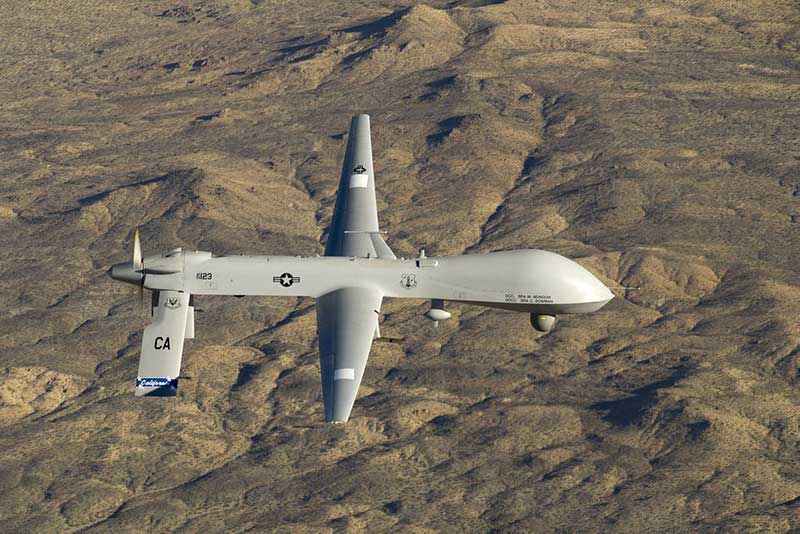- ISIS doesn’t need the latest Predator drone
- Commercial drones have already found their place in the terrorist’s plans
- Small commercial drones are a big problem
- Swarms of death – the future of the battlefield
- No easy responses to the threat of flying bombs
“While UAVs have many positive applications, it’s expected that they’ll be used increasingly for malicious purposes – they can carry cameras, weapons, toxic chemicals and explosives – and be used increasingly for terrorism, espionage and smuggling purposes.”
— Colin Bullock, CEO of Enterprise Control Systems
ISIS doesn’t need the latest Predator drone
When you think of drones as weapons of war, you probably imagine the military versions flown by the US or Russia. These expensive, high-tech aircraft allow major militaries to tirelessly patrol the skies, striking enemy targets as they become available. But they are as effective as they are expensive, far out of the reach of even the best funded terror groups. But ISIS doesn’t need the latest Predator drone. The terrifying truth is that inexpensive, readily available unmanned aerial vehicles (UAVs) are increasingly being used as tools of murder by ISIS and other terrorist organisations. You need to know why and how this trend is developing.

Commercial drones have already found their place in the terrorist’s plans
Drones are far more than remote controlled vehicles. When fitted with a camera and mobile, they provide wireless control at a distance. They’re nimble and fast, small and cheap. Widely available from big box stores and Amazon, drones are everywhere. And they’re a growing threat that has experts concerned. Commercial drones have already found their place in the terrorist’s plans.
According to Tech Insider’s Danielle Muoio, ISIS included reconnaissance drones in its Fallujah campaign in Iraq, scouting Iraqi military positions and planning a coordinated attack. Again in 2014, ISIS flew the same style of drone prior to capturing the Taqba airbase. A third such incident was recorded in 2015, when ISIS shared video of their drone recon of the Baiji oil refinery complex. These drones were the ubiquitous DJI Phantom, a common consumer UAV available on Amazon for about $450. Fitted with a GoPro camera, this tiny drone, only a bit bigger than a dinner plate, is an ideal reconnaissance platform.
We suggest that you see this as a settle pattern, not a series of one-offs. ISIS knows that the Phantom can scout defences. It can map streets. It can locate soldiers and command posts. It can watch for approaching police to better time a secondary explosion. Unfortunately, that’s not the limit of these small, capable UAVs.
Small commercial drones are a big problem
Commercial drones are a major threat because they are so inexpensive and widely available. Anti-UAV systems, by contrast, are hideously expensive and not nearly as effective as you’d hope. Blighter, for instance, developed perhaps the most advanced commercially available anti-drone weapon, the Anti-UAV Defence System (AUDS). It’s been dubbed the ‘Drone Zapper’ because of its ability to target and disable an incoming drone with RF interference, essentially killing command of the UAV. But these systems are as costly, and buyers must spend approximately $1.2 million per AUDS instillation. It’s easy to see that as effective as these might be might be for securing select locations, their broad application simply isn’t feasible.
Moreover, a small swarm of drones could overwhelm this expensive security system. For obvious reasons, the AUDS’s limitations aren’t entirely clear, but two problems are. First, buildings and other line-of-sight obstructions can limit the effectiveness of anti-UAV systems in urban areas. And second, only one drone at a time can be targeted. As Miltech Mag reports, the “AUDS is capable of tracking multiple targets although only a single UAV could be disrupted at any particular moment… subsequent targets could be prioritised for follow-on neutralisation.” That’s less re-assuring than it sounds. A $1.2 million dollar system can only target one $450 drone at a time.
Anyone can do the math: $1.2 million/$450 (for the DJI Phantom preferred by ISIS) means that with equal funding, terrorists can launch almost 27,000 drones, and they can be anywhere, anytime, in overwhelming numbers. It is simply inconceivable that even stacked AUDS could deal with a drone swarm of more than several dozen UAVs, and that lowers the cost of an attack to just a few thousand euro.
Swarms of death – the future of the battlefield
The cost of overwhelming even the most sophisticated anti-drone systems is negligible. In fact, this inexpensive swarm tactic is so effective that it has already been adopted by the US military. The US Navy has launched its LOCUST program, or ‘LOw-Cost Unmanned aerial vehicle Swarming Technology.’ Tired of losing expensive aircraft to cheap countermeasures like shoulder fired rockets, the Navy is an early adopter of this new approach. Popular Science reports that the new strategy avoids expensive, advanced tech; the emerging plan “is instead to throw lots of smaller, cheaper robots into the sky, with a single human controlling them from afar, and let the enemy waste expensive anti-air missiles on drones, while redundant swarm members complete the mission.”
Israel is in on the small drone action, too. It recently announced the Hero-30, a small, lightweight, single-use UAV that delivers a small (500g) warhead. By independently tracking its target, it can exceed the manoeuvrability of a human controller and strike moving targets such as vehicles. Virtually silent and launched at distance, these weapons are the future of the battlefield. Israel is unlikely, of course, to share this tech with the likes of ISIS and Al Qaeda. But terrorists are watching, calculating, and planning, and this is an easy, inexpensive strategy to employ.
No easy responses to the threat of flying bombs
Keep in mind that commercial drones aren’t just flying cameras. They can lift other small payloads. In practice, this means that terrorists could construct flying IEDs to wreak havoc. A clever terrorist cell could construct pre-fragmented bombs—basically an explosive charge attached to steel bearings or nails or glass—and equip a drone with this deadly package. Flying low over a crowd in an urban centre or sports arena, they could detonate this explosive above their heads, killing and injuring hundreds.
Worse yet, imagine three such drones, arriving ten minutes apart to catch first responders in secondary and tertiary strikes. We doubt that there’s any effective way to prevent such attacks, and that should keep you up at night. We’re not alone in our concern. ISIS has already demonstrated its grasp of drones as weapons, and according to the Oxford Research Group’s Remote Control Project, the “Islamic State is reportedly obsessed with launching a synchronised multi-drone attack on large numbers of people in order to recreate the horrors of 9/11.”
Unfortunately, there are no easy responses to this threat.
Share via:



